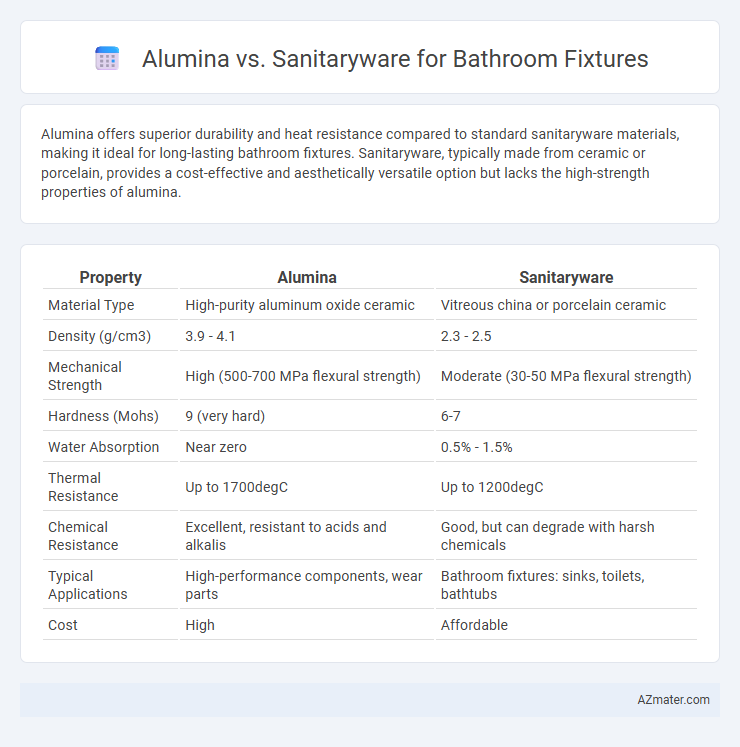Alumina offers superior durability and heat resistance compared to standard sanitaryware materials, making it ideal for long-lasting bathroom fixtures. Sanitaryware, typically made from ceramic or porcelain, provides a cost-effective and aesthetically versatile option but lacks the high-strength properties of alumina.
Table of Comparison
| Property | Alumina | Sanitaryware |
|---|---|---|
| Material Type | High-purity aluminum oxide ceramic | Vitreous china or porcelain ceramic |
| Density (g/cm3) | 3.9 - 4.1 | 2.3 - 2.5 |
| Mechanical Strength | High (500-700 MPa flexural strength) | Moderate (30-50 MPa flexural strength) |
| Hardness (Mohs) | 9 (very hard) | 6-7 |
| Water Absorption | Near zero | 0.5% - 1.5% |
| Thermal Resistance | Up to 1700degC | Up to 1200degC |
| Chemical Resistance | Excellent, resistant to acids and alkalis | Good, but can degrade with harsh chemicals |
| Typical Applications | High-performance components, wear parts | Bathroom fixtures: sinks, toilets, bathtubs |
| Cost | High | Affordable |
Introduction to Alumina and Sanitaryware
Alumina, a high-purity aluminum oxide ceramic, offers exceptional hardness, durability, and resistance to wear and corrosion, making it ideal for precision bathroom fixtures requiring long-lasting performance. Sanitaryware refers to a wide range of bathroom fixtures such as toilets, sinks, and bidets, typically made from vitreous china, porcelain, or ceramic materials known for their smooth surfaces and ease of cleaning. Comparing these, alumina provides superior mechanical strength and chemical stability, while sanitaryware prioritizes aesthetic appeal and cost-effectiveness in residential and commercial bathroom installations.
Composition and Material Properties
Alumina, a ceramic material composed primarily of aluminum oxide (Al2O3), offers exceptional hardness, high thermal resistance, and excellent chemical stability, making it ideal for durable bathroom fixtures. Sanitaryware, typically made from vitreous china or porcelain, contains a mixture of clay, feldspar, quartz, and kaolin, providing smooth glazing, stain resistance, and easy maintenance. The superior strength and scratch resistance of alumina contrast with the aesthetic finish and cost-effectiveness of traditional sanitaryware, influencing their application in bathroom fixtures.
Durability and Longevity Comparison
Alumina bathroom fixtures offer exceptional durability due to their high resistance to wear, corrosion, and thermal shock, making them a long-lasting choice for sanitaryware applications. In comparison, traditional sanitaryware made from ceramic materials tends to be more susceptible to chipping and cracking over time, reducing its overall lifespan. The superior hardness and resilience of alumina contribute to enhanced longevity, ensuring bathroom fixtures maintain functionality and aesthetic appeal for extended periods.
Aesthetic Appeal and Design Versatility
Alumina offers a sleek, modern aesthetic with a smooth, polished finish that enhances contemporary bathroom designs, while sanitaryware provides classic, timeless looks suitable for various styles from traditional to modern. Alumina's material properties allow for innovative shapes and thin-walled designs, promoting greater design versatility and customization compared to the more rigid forms of conventional sanitaryware. The choice between alumina and sanitaryware directly impacts the bathroom's visual appeal and adaptability, making alumina ideal for high-end, minimalist aesthetics, whereas sanitaryware remains favored for durability and a broader range of styles.
Water Resistance and Stain Resistance
Alumina exhibits superior water resistance due to its dense, non-porous surface that prevents water absorption, making it ideal for bathroom fixtures exposed to moisture. Sanitaryware, typically made of glazed ceramic, offers moderate water resistance but may develop micro-cracks over time, compromising durability. In terms of stain resistance, alumina resists discoloration and staining from detergents and hard water better than sanitaryware, which can stain if the glaze degrades or is damaged.
Maintenance and Cleaning Requirements
Alumina bathroom fixtures offer superior durability and resistance to stains, making maintenance easier with just regular wiping using mild detergents and non-abrasive cleaners. Sanitaryware often requires more frequent cleaning to prevent buildup of soap scum and mineral deposits, especially in high-use areas, and may need specialized bathroom cleaners to maintain its shine. Both materials benefit from routine cleaning to extend lifespan, but alumina's non-porous surface significantly reduces staining and bacterial growth compared to traditional sanitaryware.
Cost Analysis: Alumina vs Sanitaryware
Alumina bathroom fixtures typically offer a cost-effective alternative to traditional sanitaryware due to lower raw material expenses and manufacturing processes, resulting in reduced overall production costs. Sanitaryware, often made from vitrified clay or porcelain, tends to have higher initial investment costs but provides long-term durability and a premium finish, influencing total cost of ownership. Evaluating cost analysis between alumina and sanitaryware requires considering upfront purchasing price, installation expenses, maintenance frequency, and lifespan to determine the most economical option for bathroom fixtures.
Environmental Impact and Sustainability
Alumina offers significant environmental benefits in bathroom fixtures due to its recyclable nature and lower energy consumption during manufacturing compared to traditional sanitaryware like ceramic or porcelain. Sanitaryware production often involves high-temperature kiln firing, resulting in substantial carbon emissions and resource depletion. Choosing alumina fixtures supports sustainability goals through reduced waste generation, enhanced durability, and the potential for material recovery at the end of product life.
Common Applications in Modern Bathrooms
Alumina, a high-purity form of aluminum oxide, is widely used in modern bathrooms for durable, scratch-resistant surfaces such as countertops and washbasins, prized for its hardness and ease of maintenance. Sanitaryware, including ceramic toilets, sinks, and bidets, is favored for its water-resistant, hygienic properties, offering a smooth, non-porous finish that resists stains and bacteria. Both materials are integral in designing contemporary bathrooms, with alumina excelling in aesthetic and functional durability, while sanitaryware ensures optimal sanitation and comfort.
Choosing the Right Material for Bathroom Fixtures
Alumina ceramic offers superior durability, scratch resistance, and thermal stability, making it an excellent choice for long-lasting bathroom fixtures. Sanitaryware, typically made from vitreous china or porcelain, provides a smooth, glossy finish that is easy to clean and resistant to stains. Selecting the right material depends on balancing durability requirements, aesthetic preferences, and maintenance considerations for bathroom fixtures.

Infographic: Alumina vs Sanitaryware for Bathroom Fixture
 azmater.com
azmater.com